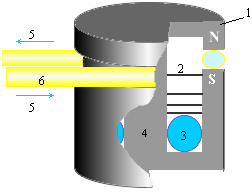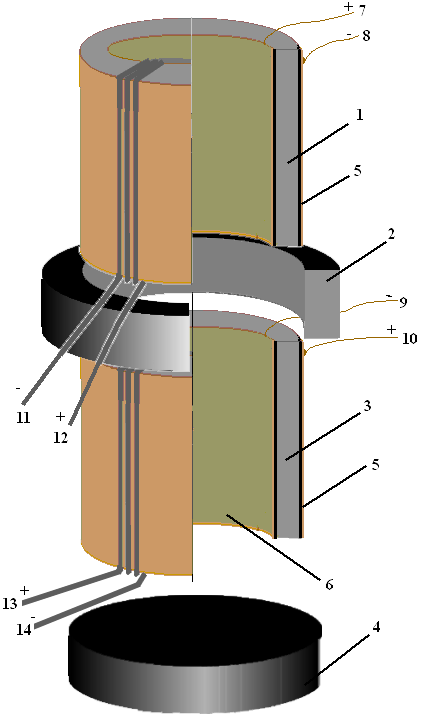Alexander A.Shpilman ( alexandrshpilman78@gmail.com )
"M-state" Elements Concentrators
The research on the design
of different types "axion field" generators
has shown that only very small quantity of generator’s working matter actually
participate in "axion field" generation and
that it is the quality (or degree) of working matter activation that varies. For
the observer, it may look like every material would possess very much the same
quantity of some kind of micro-impurity substance that actively participates in
"axion field" generation.
Let's call this impurity
"‘m-state’ element". Usually, the quantity of this micro-impurity is
proportional to the density of the working matter.
Apparently,
"m-state" element is an unknown chemical element or an isotope that
has unusual (exited) states of nucleus in its atoms. These atoms can not be
found by conventional physical-chemical methods. Obviously, to develop some
methods for "m-state" element detection one would need to have them
in large concentration. This would lead us to the question: How can we
concentrate "m-state" element?
( For related ideas look at http://www.subtleenergies.com/ormus/tw/magtrap.htm and http://www.subtleenergies.com/ormus/tw/patterns.htm )
Assuming that
"m-state" elements actively participate in "axion
field" generation, it would make sense to work with both
"m-state" elements and "axion
field", see "m-state" element concentrator shown at figure 1.
|
|
Where 1 - constant magnet,
2 - thin iron washers, 3 - substance accumulating "m-state" elements,
4 - central core of a magnet 1.
5 – liquid’s flow direction in a tube 6 (non-magnetic
material).
In the internal cavity of
the magnet 1, there is a vector potential locked around the magnet central core
4. The thin iron washers 2 with radial slit, partially
lock on themselves diffused magnetic field of the magnet 1 thus creating vector
potential gradient on the magnet cavity height. The maximal value of vector
potential will be in zone 3.
Suppose that
"m-state" elements will be pushed out from the liquid substance 5
into the internal cavity of a magnet with magnetic field, and drift to the area
with the greatest value of vector potential, i.e. into zone 3.
Let’s place some ferrite
material or fibre optic cable into zone 3. These
materials can be used later in "axion
field" generators as working body. (for example,
in the generator The Generator of "Axion
(Spin) Feld" - "COMFORT" ). We can also put purified water
into zone 3 and try to accumulate "m-state" elements in it.
This water can be used
later in biological experiments or in physical-chemical experiments on detection
and study of "m-state" element properties.
The wall of test tubes is
not the obstacle for "m-state" element. Apparently we’ll not find any
"m-state" element in the sediment if we evaporate the water but we
can try chemically bond "m-state" elements of heavy nucleuses (gold,
platinum etc.) with sodium or oxygen (O6) as they try in http://www.subtleenergies.com/ormus/tw/methods.htm .
Suggested design would have
the magnet assembled from sections, this would allow us retrieve
"m-state" element accumulating substance (3) from the device without
crossing magnetic field of the magnet.
Constant flow of substance
in tube 6 would supply the device with new "m-state" elements. This
substance can be a water, petroleum, an air or moving aluminium wire.
The concentrator collects
"m-state" elements not only from the liquid substance that flowing
through the magnet but also from the environment. Therefore, it is unknown,
what would be consequences for biological objects that stay near the
concentrator for a long period of time.
High concentration of "m-state" elements
can be observed in mountains, in points of the increased intensity of the
"geo-field", along high-voltage powerlines
and electricity distribution stations, near power station heat furnace and, in
particular, around nuclear reactors and radioactive waste storehouses.
To collect disseminated
"m-state" elements in such zones we can use the design similar to one
that is shown on Fig.1. The difference is that there is no horizontal slit in
the tube 6 (the magnet with complete magnetic field shortcut) but there are
four radial narrow vertical slits through the thickness of the wall.
For "m-state"
element accumulation, such construction can be merely submerged into the river
or sea currents.
It is estimated that for
"m-state" element extraction it is necessary to apply more than 10 keV of energy per one atom nucleus.
|
|
Good candidates for
"m-state" element manufacturing would be cathode-ray tub (CRT) of
modern colour TV sets and computer monitors. Jets of
"m-state" element that flow from TV tub are basically observed along
CRT shadow mask plane (along TV screen surface). The amount of jets and their
directions are determined by CRT and housing geometry.
The design developed
especially for "m-state" element accumulation from TV’s CRT shown on
Fig.2 (in a section)
Where 1
and 3 - ferrite tube with low electrical conductivity, 2 - ferrite where
"m-state" elements concentrate), 4 - graphite disk, 5 and 6 -
external and internal copper electrodes.
Before final construction
assembly both external and internal surfaces of ferrite tubes 1, 3 should be
covered with graphite and electrodes 5, 6 pressed tightly against them (or
these electrodes can be made electrolytic precipitation copper on graphite).
Electrical current applied
to toroidal coils through wires 11,12
and 13,14 thus creating opposite direction magnetic field in ferrite tubes 1,
3. Note that potential vector inside tubes also has an opposite orientation. Potential
vectors in tubes 1 and 3 sum their radial components in a zone of ferrite ring
2.
Magnetic field created by
the coils should be close to magnetic saturation of ferrite tube 1, 3. The
design will be simpler, if low electrical conductivity constant magnets were
used instead of ferrite tubes.
Opposite sign voltage
applied to the coils wires 7,8 and 9,8; electrodes 5
and 6 of corresponding tubes 1 and 3, so that in both ferrite tubes
perpendicular magnetic and electrical fields being formed with a Poyting vector directed upwards.
There are two working
factors in this design:
-
"m-state" elements concentration in a zone with maximum value of
vector potential (zone of the ring 2), by concentrating "axion field" of "m-state" elements in this
zone;
-
"m-state" elements concentration by concentrating "axion field" of type 3 (Fig.3 in article "The
optical generator of "Axion (Spin) Field" with
cross by EM-fields"),
with the use of a Poyting vector .
(Analogy, the iron sawdust
is draw in area of the greatest intensity of a
magnetic field, it is supposed, that the "m-state" elements are draw
in area of greatest density of a "axion field
".)
The efficiency of "axion field" generation significantly increased when
materials saturated by "m-state" elements used as a working body in
"axion field" generators (for example,
generator "COMFORT").
So far the limit of such
"m-state" elements saturation has not yet discovered.
There is an assumption,
that some critical level of "m-state" elements concentration exists,
the object that reaches it becomes "the magic object" and should
demonstrate some unusual effects (for example, imitation poltergeist).

